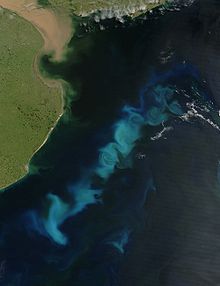Iron fertilization

Iron fertilization describes the targeted fertilization of the surface water of certain areas of the ocean with the aim of promoting algae growth. It is particularly relevant in connection with the removal of carbon dioxide from the atmosphere. In particular, iron fertilization and its effects on marine ecosystems are currently being investigated experimentally and discussed controversially.
The basic idea
A large number of scientific studies in the field of geosciences over the last decades have shown that algae growth in certain parts of the oceans - the so-called HNLC areas - can be significantly accelerated by adding iron as a micronutrient . In the course of the current attempts to avoid unnecessary carbon dioxide emissions or to remove carbon dioxide from the atmosphere, attempts are being made here to remove carbon dioxide from the atmosphere through photosynthesis of the globally most important biomass producers, the algae . Several such experiments have already been carried out and the limiting effect of the micronutrient iron has been sufficiently confirmed.
Methods
When CO 2 sequestration , there are different approaches. So there is the idea of promoting the multiplication of algae by introducing iron sulphate , so that they remove the CO 2 from the atmosphere by means of photosynthesis as part of an artificially induced algal bloom . Such experiments were and are u. a. carried out by the Alfred Wegener Institute (AWI), see:
- Eisenfertilizationsexperiment LOHAFEX of Indo-German Partnership for Observation of the Global Oceans (POGO).
- EisenExperiment EisenEx of the AWI in November 2000
- CROZEX (CROZet natural iron, algae bloom and EXport experiment)
However, more recent research results have shown that the introduction of iron sulfate has a much smaller effect on CO 2 degradation than hoped, since the export production of phytoplankton is only one to three percent.
The much larger part of the additionally generated algae biomass is immediately reprocessed through higher trophic levels , i.e. This means that it is converted into biomass by organisms that feed on algae and thus does not contribute directly to a reduction in the carbon dioxide content in the atmosphere. Later, on the other hand, when the fish dies or all organisms that feed on algae, they sink to the sea floor and form a natural carbon sink for the CO 2 there . The time lag between the produced algae mass in the sea and the process up to the storage on the seabed is considered to be negligible, especially since the creatures in the sea have their natural digestive processes in addition to their life cycle.
shipping
Thousands of tons of iron are brought into the North Pacific every year through exhaust gases from cargo ships . This makes shipping (according to the Japanese Institute for Marine Research and Technology JAMSTEC ) the largest source of iron compounds in this region. However, doing so is legal and does not violate the United Nations geoengineering moratorium as it happens unintentionally.
Public debate in January and February 2009
There is a controversial discussion about the possible effects of large-scale iron fertilization on ocean ecosystems. Proponents of marine fertilization argue that the substances introduced by the fertilization, such as iron sulphate, also occur under natural conditions in the oceans, which simulate the natural mixing of the water layers. Prof. Andrew J. Watson of the University of East Anglia believes that iron fertilization, if done properly, will carry CO 2 to where it naturally ends up ("... on the seabed) for centuries. the place that it would ultimately end up anyway "). Opponents like Stephan Lutter from the nature conservation organization WWF , on the other hand, fear considerable changes if the ecosystem is affected. He sees this as a threat to biodiversity . The Federal Ministry for the Environment, Nature Conservation and Nuclear Safety (BMU) is also critical of experiments on marine fertilization, as "the indirect consequences for marine ecosystems are difficult to assess". The BMU and the Federal Ministry of Education and Research agree that “iron fertilization must not become an instrument of climate policy”. In the fourth assessment report, however, the IPCC found that none of the expected negative consequences could be found in the experiments.
Web links
- Floarian Rötzer: Companies are starting large-scale tests of sea fertilization in Telepolis on heise.de
- Joachim Müller-Jung: Cast off for marine fertilization on the FAZ website
- Alok Jha: Ocean iron plan approved as researchers show algae absorb CO2 on the Guardian's website
- Could Iron Fertilization Of Oceans Combat Global Warming? on Science Daily
Individual evidence
- ↑ Nature 457 (January 29, 2009), 577-580: Letter. Southern Ocean deep-water carbon export enhanced by natural iron fertilization. ISSN 0028-0836
- ↑ newscientist.de: Fertilizer from the chimney (2012) ( Memento from April 12, 2013 in the web archive archive.today )
- ↑ Oceanus: [1] (accessed March 29, 2010)
- ↑ Spiegel Online: The sea becomes a bioreactor (accessed on January 30, 2009)
- ↑ a b Federal Ministry for the Environment, Nature Conservation and Nuclear Safety: Federal Environment Ministry regrets the release of the iron fertilization experiment (accessed on August 3, 2018)
- ↑ IPCC: PDF (accessed March 29, 2010)